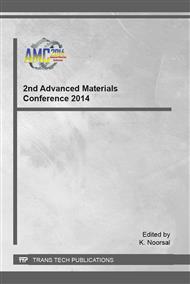[1]
D.K. Bhui, A. Misra, Synthesis of worm-like silver nanoparticles in methyl cellulose polymeric matrix and its catalytic activity, Carbohydr. Polym. 89 (2012) 830-835.
DOI: 10.1016/j.carbpol.2012.04.017
Google Scholar
[2]
J. Liu, H. Wang, S. Dong, F. Wang, Y. Dong, Effect of Ag shapes and surface compositions on the photocatalytic performance of Ag/ZnO nanorods, J. Alloy Compd. 617 (2014) 869-876.
DOI: 10.1016/j.jallcom.2014.08.096
Google Scholar
[3]
M.D.L.R. Peralta, U. Pal, R.S. Zeferino, Photoluminsence (PL) quenching and enhanced photocatalytic activity Au-decorated ZnO nanorods fabricated through microwave-assisted chemical synthesis, Appl. Mater. Interface 4 (2012) 4807-4816.
DOI: 10.1021/am301155u
Google Scholar
[4]
H. Chen, C.P. Chen, C. -T.R. Yu, Y.T. Chen, C. -C. Teng, K. -Y. Lo, C.H. Lin, B. -Y. Huang, Distint spatial profiles and antibacterial effects of 20 nm Ag nanoparticles dripped on ZnO nanorods grown on a polished Ti substrate, Appl. Surf. Sci. 311 (2014).
DOI: 10.1016/j.apsusc.2014.05.077
Google Scholar
[5]
M. Mahanti, D. Basak, Enhanced photoluminscence in Ag@SiO2 core-shell nanoparticles coated ZnO nanorods, J. Lumin. 154 (2014) 535-540.
DOI: 10.1016/j.jlumin.2014.05.023
Google Scholar
[6]
O.V. Kharissova, H.V. Rasika Dias, B.I. Kharisov, B.O. Perez, V.M. Jimenez-Perez, The greener synthesis of nanoparticles, Trends Biotechnol. 31 (2013) 240-248.
DOI: 10.1016/j.tibtech.2013.01.003
Google Scholar
[7]
N. Mat Zain, A.G.F. Stapley, G. Shama, Green synthesis of silver and copper nanoparticles using ascorbic acid and chitosan for antimicrobial applications, Carbohydr. Polym. 112 (2014) 195-202.
DOI: 10.1016/j.carbpol.2014.05.081
Google Scholar
[8]
S. Shankar, X. Teng, J. -W. Rhim, Properties and characterization of agar/CuNP bionanocomposite films prepared with different copper salts and reducing agents, Carbohydr. Polym. 114 (2014) 484-492.
DOI: 10.1016/j.carbpol.2014.08.036
Google Scholar
[9]
J. Andas, F. Adam, I. Ab. Rahman, Sol-gel derived mesoporous cobalt silica catalyst: Synthesis, characterization and its activity in the oxidation of phenol, Appl. Surf. Sci. 315 (2014) 154-162.
DOI: 10.1016/j.apsusc.2014.07.118
Google Scholar
[10]
F. Adam, J. Andas, Amino benzoic acid modified silica-An improved catalyst for the mono-substituted product in the benzylation of toluene with benzyl chloride, J. Colloid Interf. Sci. 311 (2007) 135-143.
DOI: 10.1016/j.jcis.2007.02.083
Google Scholar
[11]
F. Adam, J. Andas, I. Ab. Rahman, A study on the oxidation of phenol by heterogeneous iron silica catalyst, Chem. Eng. J. 165 (2010) 658-667.
DOI: 10.1016/j.cej.2010.09.054
Google Scholar
[12]
M. Faizal, H. Bouzid, F.A. Harraz, A.A. Ismail, S.A. Al-Sayari, M.S. Al-Assiri, Mesoporous Ag/ZnO multilayer films prepared by repeated spin-coating for enhancing its photonic efficiencies, Surf. Coat. Tech. 263 (2015) 44-53.
DOI: 10.1016/j.surfcoat.2014.12.063
Google Scholar
[13]
J. Andas, F. Adam, I. Ab. Rahman, Heterogeneous copper-silica catalyst from agricultural biomass and its catalytic activity, Appl. Surf. Sci. 284 (2013) 503-513.
DOI: 10.1016/j.apsusc.2013.07.125
Google Scholar
[14]
A.E. Ahmed, F. Adam, Indium incorporated silica from rice husk and its catalytic activity, Micropor. Mesopor. Mater. 103 (2007) 284-295.
DOI: 10.1016/j.micromeso.2007.01.055
Google Scholar


